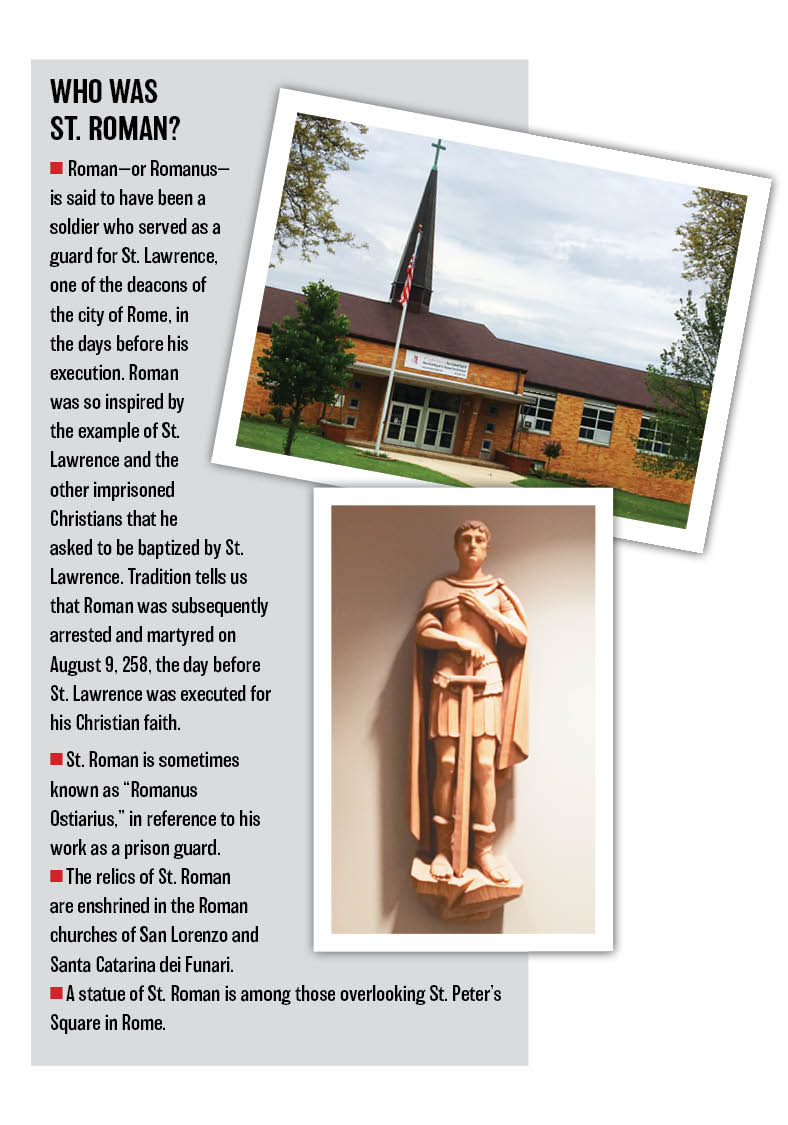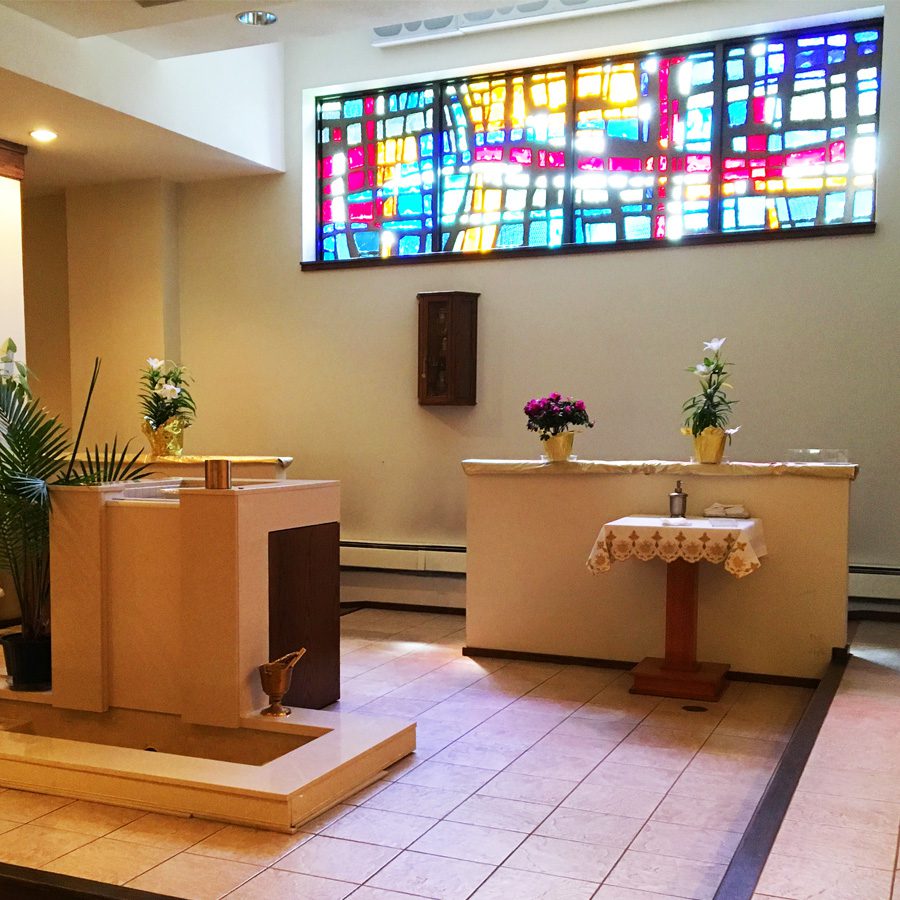St. Roman Parish in Milwaukee

Upper: The parish (West Bolivar entrance) embraces the Catholicism of many lands and peoples. Lower: The statue of the parish patron St. Roman.
“Every new parish is a challenge to the priest chosen to organize it, but it is a special challenge to its present and future parishioners. We are to build not only for ourselves, but for those who are to follow us.” With those words, Father Maximilian “Max” Adamski began a 1958 letter to parishioners of the newly-formed St. Roman’s Parish, asking them to pledge their financial support in building a new church and school. “We are doing this for God and His children of the present and future generations,” Fr. Adamski’s letter continued, “We are doing this also as a part payment for the precious gift of faith inherited from our parents, and we want others to continue to share and enjoy it in future years.”
When Fr. Adamski arrived at the site designated for the new parish, at the corner of S. 20th Street and West Bolivar Avenue, he was greeted by eleven acres of weeds and corn stalks. But, dedicating the new building project to the Sacred Heart of Jesus and asking the intercession of the Blessed Virgin Mary, he began the work of forming the new community. He moved into the parish’s first rectory on January 29, 1957, and immediately began a parish census as a way of getting to know his new parishioners. The parish’s first “office” was the kitchen of a local grocery store. The new parish was dedicated to an early martyr, St. Roman, in honor of Bishop Roman R. Atkielski, one of the auxiliary bishops of the Archdiocese of Milwaukee.
The first Masses for the new parish were celebrated in the chapel of the former St. Joseph’s Home for Children, an orphanage staffed by the Felician Sisters. An early parish history notes that only six people were present at each Mass, but soon families were coming together, helping make the new parish a vibrant part of the local community. In 1959, the cornerstone for the building that would house both the church and parish school and the first Mass — a wedding — took place in the newly completed church on August 1, 1959. The church was officially dedicated on April 24, 1960.

The baptismal area of St. Roman’s.
St. Roman’s School opened in September, 1959, with an enrollment of 304 students, and was staffed by both Felician Sisters and lay teachers. It remains an important part of the parish, serving diverse students from throughout the community.
This diversity is an important part of the life and identity of St. Roman’s, as pastor Fr. Brian Holbus, has observed. “St. Roman represents the ongoing presence of the Roman Catholic Church in an area that at one time was predominantly Catholic. As the population of the neighborhood has welcomed families from different parts of the world in recent decades, St. Roman has had to embody the universal embrace of Roman Catholicism of many lands and peoples.” Fr. Holbus recognizes this aspect of life at St. Roman’s as being tied to the broader mission of the Church: “The Catholic Church, by its very nature and from its very beginnings, is a multi-national, global community,” Fr. Holbus said. “Jesus commanded his followers to ‘go into the whole world’ and to ‘make disciples of all the nations.’ Although it is much more comfortable to belong to a parish in which everyone looks and sounds the same, our identity and our mission is enhanced when we are able to be Catholic in every sense of the word. At St. Roman, we have the privilege and the challenge of being a multicultural parish.”
Fr. Holbus has served as pastor of St. Roman’s since 2009, and is assisted in his ministry by Fr. Norberto Sandoval. Together, the two priests also provide pastoral care for Milwaukee’s St. Charles Borromeo Church.
“When I arrived at St. Roman Parish,” Fr. Holbus said, “we already had a significant Hispanic enrollment in our school. That has increased, as we have welcomed more Hispanic families into our neighborhood. But, we also have boys and girls whose parents came as refugees from Myanmar,  more recently. As new people have come into our community, others have moved farther out into the suburbs. City workers (police officers, firefighters, teachers, etc.) are no longer required to live within the city boundaries. That change in policy has affected our parish composition and school enrollment as well. The challenge of the present moment is to be authentically Catholic and effective witnesses to the love of Christ even as we experience these demographic shifts.”
more recently. As new people have come into our community, others have moved farther out into the suburbs. City workers (police officers, firefighters, teachers, etc.) are no longer required to live within the city boundaries. That change in policy has affected our parish composition and school enrollment as well. The challenge of the present moment is to be authentically Catholic and effective witnesses to the love of Christ even as we experience these demographic shifts.”
As part of this witness of Christ’s love, St. Roman’s engages in a number of outreach programs, including the St. Roman Food Pantry and an active parish conference of the St. Vincent de Paul Society. The annual parish festival — which dates back to the earliest days of the parish — is also a time of outreach and engagement with their Garden District neighbors and the broader community, drawing Catholics and non-Catholics alike to St. Roman’s each Father’s Day weekend.
The spirit of service is part of what keeps parishioner Sharon Goodman and her family part of the St. Roman’s community. “Our family joined St. Roman Parish in 1976. We choose to remain here because of the friendships we’ve made over the years and the opportunities we’ve had to contribute to help our parish stay significant in our community,” Goodman said.
Seeing St. Roman’s as a parish that works to continually grow in its spiritual identity and service to the community, Goodman looks to two important annual events as having special significance. “Our Triduum services, especially the Easter Vigil, have been a constant source of affirmation of our faith and traditions. I really appreciate the solemnity and symbols used to remind us of what Jesus did for us. The Triduum services, in the religious sense, and our parish festival, in the social sense, are both important parts of our parish life.”
For Joyce Randow, who came to St. Roman’s in 1959, the parish has truly become a home. “This was the parish we were assigned to and we wanted to send our kids to the Catholic school,” Randow recalled. Over time, however, the ties with the parish grew stronger. “Our parish is a place we can gather and pray. Our weekday Mass people have become a family. We are a welcoming parish. When we ask for help,” Randow concluded, “we get a good turnout.”
